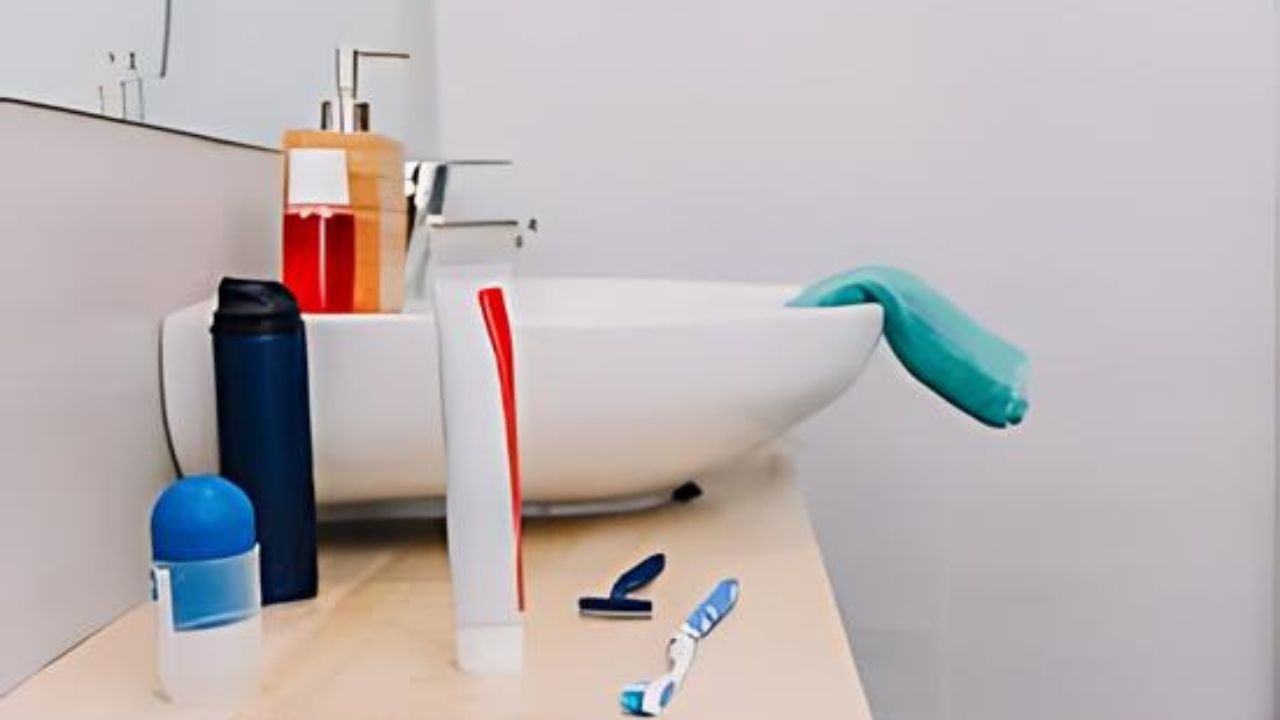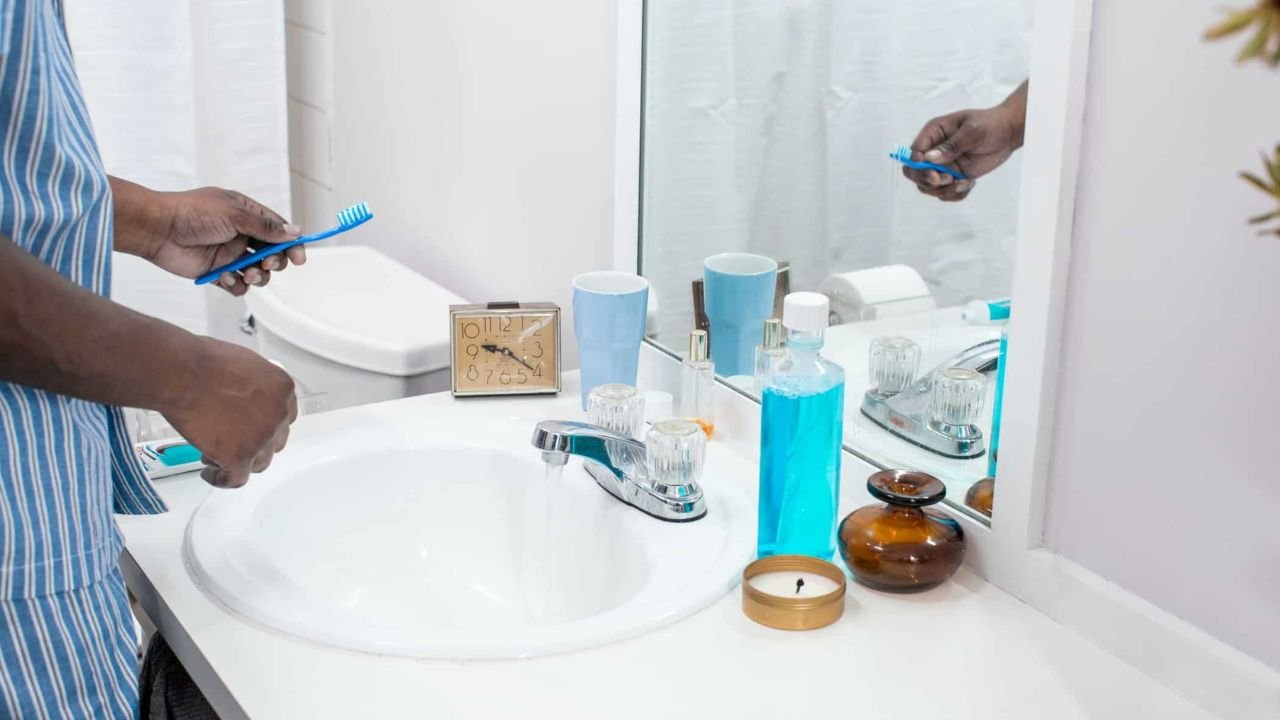Why does my bathroom smell like sewage? This question often looms large in the minds of many homeowners, leading to discomfort and concern. If you’re noticing this foul odor or bad sewage smell, it’s usually a sign that something’s amiss and needs immediate attention. From blocked sewer lines to dry P-traps and broken seals, several factors could be the culprits behind that persistent stench of unpleasant sewage odor.
- 01. Common Causes of a Sewage Smell in the Bathroom
- 02. How to Identify the Source of the Smell
- 03. DIY Solutions to Eliminate Sewage Smells
- 04. Try Natural and DIY Remedies
- 05. When to Call a Professional
- 06. Preventing Future Odors
- 07. Frequently Asked Questions
- 08. Top 5 Amazon Products to Eliminate Bathroom Sewage Odors
- 09. Conclusion - Why Does My Bathroom Smell Like Sewage
Addressing this issue promptly is crucial not only for your comfort but also to prevent potential health hazards and further damage to your plumbing system. In this post, we’ll uncover the shocking causes behind a bathroom that smells like sewer gas and what you can do to fix it, including plumbing advice.
01. Common Causes of a Sewage Smell in the Bathroom
Discovering that your bathroom smells like sewage can be quite alarming. This issue signals potential problems within your home’s plumbing system. Let’s explore some of the common causes behind this unpleasant odor.
A. Dry P-Trap
A P-trap is a u-shaped pipe found under sinks and other fixtures. Its primary job is to hold a small amount of water, which acts as a barrier to keep sewer gases from entering your home. If the P-trap dries out—usually due to infrequent use—it loses its water seal, allowing these gases to escape.
Learn how to fix a dry P-trap.
B.Blocked Sewer Line
A blocked sewer line can lead to a sewage smell in your bathroom. Blockages may occur due to a buildup of debris, non-flushable items, or even tree roots infiltrating the line. Signs of a blockage include:
-
Slow drains
-
Gurgling sounds from the toilet
-
Water backups in sinks or bathtubs
Common causes like tree roots and debris are often discussed in plumbing informational resources.
C. Clogged Shower Drain
A clogged shower drain can also contribute to foul odors in your bathroom. Soap scum, hair, and other debris can build up over time, leading to standing water and bacteria growth, which emits bad smells. It’s essential to regularly clean and maintain your drains to avoid these issues.
For more plumbing advice and insights, you might find this guide on handling clogged drains helpful.
D. Cracked Sewer Line
A cracked sewer line can develop due to ground movement, natural wear and tear, or tree roots. These cracks can release sewage gas into your home, causing a noticeable odor. Regular inspections and prompt repairs are crucial to address this issue.
Alert: Recognize signs of cracked sewer lines.
E. Septic Tank Problems
Septic tank issues, like overflows or blockages, can cause a sewage smell to waft into your bathroom. When the septic tank is full or the lines are clogged, the gases have nowhere to go but up through your plumbing system.
For Further Reading: Understanding septic tank issues.
F. Bacteria Growth
Bacteria growth in your drains and pipes can produce a foul odor similar to sewage. Warm, moist environments are perfect breeding grounds for bacteria, which can release gases as they break down organic material.
G. Sewer Gas Leak
A sewer gas leak is a serious issue. Sewer gas contains harmful components like methane and hydrogen sulfide, which can pose health risks if inhaled in large amounts. Leaks can occur due to:
-
Faulty seals
-
Cracked pipes
-
Poor ventilation
Important: Identify and mitigate sewer gas leaks.
02. How to Identify the Source of the Smell
Figuring out why your bathroom smells like sewage can be tricky. It’s not just one thing that can cause the smell; it could be any number of issues. It’s important to find the source of the smell to fix it properly and keep it from coming back. Here’s how you can identify where that unpleasant odor is coming from:
A. Checking the P-Trap
The P-trap is a u-shaped pipe located under your sink and other fixtures. It holds water to block sewer gases from entering your home. Sometimes, especially if you don’t use a particular drain often, the P-trap can dry out.
Steps to check if the P-trap is dry:
-
Look under your sink: Find the u-shaped pipe, this is your P-trap.
-
Check for water: Touch the outside. If it feels warm or dry, it might be empty.
-
Fill the trap: Pour a bucket of water down the drain. This should fill the P-trap and stop the sewer gases.
Keeping the P-trap filled with water can help keep the sewer smell at bay.
B. Inspecting Drains and Vents
Blocked drains and vents can cause unpleasant smells. Clear blockages to ensure proper airflow and drainage.
Inspection tips:
-
Check all drain openings: Look at your sinks, showers, and toilets. Hair and debris can build up, causing blockages.
-
Use a plumbing snake or a coat hanger: You can use these tools to clear out any clogs.
-
Check vent pipes: Make sure your roof vent pipes are not clogged with debris such as leaves or nests. You might need to get onto your roof or call a professional for help.
You can also refer to this guide on handling clogged drains to gather more insights.
C. Using a Smoke Test
A smoke test can help you find cracks or leaks in the sewer line that may be allowing sewer gases into your home.
How to perform a smoke test:
-
Get a smoke generator: A plumber often performs a smoke test using this machine.
-
Introduce smoke: The machine fills your drain system with non-toxic smoke.
-
Observe: Carefully watch for areas where the smoke escapes—this could indicate a crack or leak.
This method is efficient and highly recommended for pinpointing the source of the smell. For more details, Cummings Plumbing provides a thorough explanation of the smoke test process.
Identifying the source of a sewage smell in your bathroom can be straightforward if you follow these steps carefully.
03. DIY Solutions to Eliminate Sewage Smells
Is your bathroom smelling like sewage? There are simple DIY methods to help you eliminate those odors and keep your bathroom smelling fresh. Here’s how:
A. Cleaning Drains
Regularly cleaning your drains is a straightforward way to battle sewage smells. You don’t need any fancy cleaners—household items like baking soda and vinegar work wonders.
Here’s what you can do:
-
Pour half a cup of baking soda down the drain. Baking soda acts as a natural deodorizer and helps to break down minor clogs.
-
Follow with one cup of vinegar. Vinegar reacts with the baking soda, fizzing up to clear away debris and kill odor-causing bacteria.
-
Let it sit for about 15 minutes. This gives the ingredients time to work their magic.
-
Flush the drain with boiling water. Boiling water helps to melt away any remaining gunk and thoroughly flushes out the drain.
For a more detailed guide on how to clean your drains effectively, check out this resource.
B. Maintaining Water Levels in Traps
Your bathroom traps need water to form a barrier that blocks sewer gases from entering your home. If you have drains that are used infrequently, maintaining water levels in traps is essential.
Follow these steps:
-
Run water through your drains weekly. Simply turn on the tap for a minute or so. This helps keep the trap filled and prevents it from drying out.
-
Add water manually. For rarely used drains, pour a quart of water down the drain every few weeks to keep the trap wet.
This proactive step ensures that your P-traps remain effective at stopping sewer gases. Learn more on how to maintain your P-traps here.
C. Using Enzyme Cleaners
Enzyme cleaners are great for breaking down organic materials in drains and pipes. These cleaners contain natural enzymes that digest organic matter, helping to clear out clogs and eliminate odors.
Here’s how to use them:
-
Choose an enzyme cleaner designed for drains. They are widely available at hardware stores or online.
-
Follow the product instructions. Generally, you will pour the enzyme cleaner down the drain and leave it overnight.
-
Run hot water through the drain in the morning. This helps to flush out any remaining residue and activates the enzymes further.
Enzyme cleaners not only fight sewage smells but also keep your drains clear of build-up. To use enzyme cleaners effectively, consider advice found here.
These DIY methods are easy to implement and can help you get rid of those foul sewage smells in no time. Keep your drains clean, and your traps filled, and use enzyme cleaners regularly to maintain a fresh-smelling bathroom.

04. Try Natural and DIY Remedies
Finding out your bathroom smells like sewage is never fun. Luckily, there are some effective natural and DIY remedies that you can use to clear out those nasty odors. Follow these simple suggestions to make your bathroom smell fresh again.
A. Baking Soda and Vinegar
The classic combination of baking soda and vinegar is incredibly effective for eliminating sewage smells from your bathroom.
Here’s how you can use this natural remedy:
-
Pour one cup of baking soda down the smelly drain.
-
Follow with one cup of white vinegar.
-
Allow the mixture to fizz and bubble for about 10-15 minutes.
-
Rinse with a pot of boiling water.
This method works because the baking soda neutralizes odors while the vinegar breaks down organic material in the drain. For more on this method, check out the detailed guide from Romeoville’s Drain and Sewer Odors.
B. Hot Water Flush
Sometimes, a simple hot water flush can help eliminate mild sewer smells trapped in pipes.
Follow these steps:
-
Boil a large pot of water.
-
Carefully pour the boiling water down the drain.
-
Run hot tap water for a few minutes afterward.
The boiling water helps melt away any grease or buildup that might be causing the odor. This is a straightforward and effective solution that you can do regularly. More tips on this can be found on HowStuffWorks.
C. Lemon and Baking Soda
Another easy remedy is using lemon juice and baking soda. This combination not only smells good but also works well to clear out odors.
Here’s what you need to do:
-
Pour a half-cup of baking soda into the drain.
-
Follow with a half-cup of lemon juice.
-
Let it sit for about 15 minutes.
-
Flush with hot water.
This method leaves a pleasant citrusy scent while breaking down the gunk in the pipes. For a detailed explanation, you can read about it on American Home Water.
D. Enzyme Cleaners
Enzyme cleaners are a natural way to fight persistent sewage smells and keep your drains clean.
Steps to use enzyme cleaners:
-
Purchase an enzyme cleaner that’s safe for drains.
-
Follow the product instructions, usually involving pouring some down the drain and leaving it overnight.
-
In the morning, flush the drain with hot water to activate the enzymes.
Enzymes digest organic material in the pipes, which can significantly reduce odors. Using enzyme cleaners regularly helps maintain clean, odor-free drains. For more insights, visit the GoodBee Plumbing guide.
E. Preventing Dry P-Traps
A common cause of sewage smells is dry P-traps. These traps need water to create a barrier that prevents sewer gases from entering your bathroom.
Here’s how to maintain them:
-
Periodically run water through your drains.
-
For infrequently-used drains, pour a quart of water down them every few weeks.
Ensuring that your P-traps stay wet will help prevent smells from creeping up. More on keeping P-traps filled can be found at Hoffmann Bros.
Trying these natural and DIY methods can significantly reduce or even eliminate the sewage smell in your bathroom. They’re simple, cost-effective solutions that not only address the immediate problem but also help maintain a clean and fresh-smelling bathroom.
05. When to Call a Professional
When your bathroom smells like sewage, trying to fix it yourself makes sense. However, there are times when professional help is not just recommended but necessary. Here’s when you should call in the experts.
A. Persistent Odors
If you’ve tried various DIY solutions like unclogging drains, maintaining water levels in traps, and cleaning with natural remedies but still can’t shake that sewage smell, it’s time to call a plumber. Persistent odors might indicate a more significant problem in your plumbing system that requires specialized tools and skills to identify and fix.
Ignoring a continuous odor not only keeps you living in discomfort but might also increase health risks. At this point, a professional can carry out a thorough inspection to find and resolve the root cause of the issue. More on when to seek help can be found here.
B.Major Sewer Line Issues
Some plumbing problems are too big for even the most skilled DIYer. Major sewer line issues like significant blockages or leaks are among these. Signs of a severe problem include multiple fixtures backing up simultaneously, gurgling sounds from drains, or wastewater pooling around your house.
Professionals can use advanced diagnostic equipment such as cameras to inspect sewer lines and accurately pinpoint blockages or damages. They can then determine whether a simple repair or a more extensive fix, like replacing part of the sewer line, is needed. Learn what to do with major sewer line issues by checking this informative guide.
C. Septic Tank Maintenance
For homes with a septic system, regular maintenance is crucial. Septic tank problems, including overflows or blockages, can cause sewage smells to permeate your bathroom and home. If you notice slow drains or a foul odor around the septic tank area, it’s essential to schedule an inspection and maintenance service.
Septic tanks should typically be inspected and pumped every 3-5 years to prevent buildup and potential system failure. Neglecting septic tank maintenance can lead to severe and costly issues. To ensure your system is functioning correctly, consult with professionals like those at Hoffmann Bros.
Calling a professional at the right time can save you a lot of trouble. Persistent odors, major sewer line issues, and septic tank maintenance are clear indicators that expert help is needed. This approach ensures that complicated problems are handled correctly, keeping your plumbing system in the best shape.
06. Preventing Future Odors
If you’ve successfully tackled the stinky issue of your bathroom smelling like sewage, the next natural step is to ensure it doesn’t happen again. Preventing future odors requires consistent maintenance and some simple habits. Let’s delve into what you can do to keep your bathroom fresh and odor-free.
A. Regular Cleaning
One of the easiest ways to keep bathroom odors at bay is through regular cleaning. Bathrooms are high humidity areas, which means they are prone to mold, mildew, and bacteria—all of which can produce unpleasant smells.
-
Disinfect surfaces: Wipe down your sink, toilet, shower, and floors regularly with a disinfectant cleaner.
-
Clean drains: Use a drain cleaner every few weeks to prevent buildup.
-
Wash bath mats and towels: These can harbor moisture and bacteria, so regular washing is essential.
Don’t let mold and mildew take over your bathroom—details can be found on how to get rid of musty smells in a bathroom.
B. Proper Ventilation
A well-ventilated bathroom is crucial for preventing odors. Good ventilation helps remove excess moisture and prevents mold and mildew growth.
-
Install exhaust fans: Ensure you have a working exhaust fan and use it during and after showers.
-
Open windows: If possible, open windows to let fresh air in and moisture out.
-
Dehumidifiers: In bathrooms without windows, a small dehumidifier can help reduce humidity levels.
For more ideas on improving bathroom ventilation, you can refer to Mr. Rooter Plumbing’s guide on public bathroom odor control.
C. Regular Plumbing Maintenance
Ensure that your plumbing system is in top condition to avoid any surprise sewage smells.
-
Check for leaks: Regularly inspect under sinks and around the base of toilets for any signs of leaks.
-
Keep drains clear: Flush drains with hot water once a week to prevent buildup.
-
Schedule professional inspections: Have a plumber inspect your system annually to catch potential issues early.
For solving persistent odors, consider a professional plumbing service as noted by Fallon Solutions.
D. Using Odor Absorbers
Odor absorbers can be a quick fix for any lingering smells.
-
Charcoal bags: These can absorb moisture and odors effectively.
-
Baking soda: Place an open box of baking soda in your bathroom to neutralize odors.
-
Essential oils: Use an oil diffuser with scents like eucalyptus or peppermint to keep the space smelling fresh.
To see effective solutions and products, consider Fresh Drop Bathroom Odor Preventor on Amazon.
E. Addressing Dry P-Traps
P-traps can dry out in infrequently used drains, letting sewage gases escape. Keep your P-traps functional by:
-
Running water regularly: Run water through seldom-used drains weekly.
-
Adding vegetable oil: A layer of vegetable oil can slow evaporation in the trap.
Understanding more about P-traps can prevent those pesky smells, as detailed by the Homes and Gardens article.
Incorporating these habits into your routine can go a long way in keeping your bathroom smelling fresh. Consistent cleaning, proper ventilation, regular plumbing maintenance, using odor absorbers, and ensuring your P-traps are wet will make all the difference.
07. Frequently Asked Questions
When your bathroom smells like sewage, it can be not only unpleasant but also concerning. We’ve gathered some frequently asked questions to help you understand why this might happen and what you can do about it.
a. What Causes a Sewer Smell in the Bathroom?
There are several potential reasons your bathroom might smell like sewage:
-
Dry P-Trap: The P-trap, a U-shaped pipe under your sink or other fixtures, may dry out if not used often. Without water to block gases, sewer smells can pass through.
-
Clogged Drains: Hair, soap scum, and other debris can build up in your drains, causing blockages that trap water and create a breeding ground for bacteria.
-
Broken or Leaking Sewer Line: A crack or break in your sewer line can allow sewer gases to seep into your home.
-
Vent Pipe Issues: Vent pipes are designed to release sewer gases outside, but blockages or damage can redirect them into your bathroom.
-
Worn-Out Toilet Seal: The wax ring around your toilet can deteriorate over time, allowing gases to escape.
For more detailed information, you can check out this article on Understanding Sewage Smells in Bathrooms.
b. How Can I Eliminate The Sewage Smell in My Bathroom?
To eliminate the sewage smell from your bathroom, consider these solutions:
-
Fill the P-Trap: Pour water down any unused drains to refill the P-trap.
-
Unclog Drains: Use a mixture of baking soda and vinegar followed by hot water to clear minor clogs.
-
Check for Leaks: Inspect under sinks and around toilets for leaks.
-
Clean the Drains: Regularly clean your drains using enzyme cleaners to break down organic material and bacteria.
-
Inspect the Vent Pipes: Ensure your roof vent pipes are not blocked by debris.
If these solutions don’t work, you might need to seek professional help.
c. Is Sewer Gas Dangerous?
Yes, sewer gas can be dangerous. It typically contains a mixture of gases including hydrogen sulfide, methane, and other toxic substances. Inhaling these gases can cause symptoms like headaches, dizziness, nausea, and even more serious health effects at high concentrations. Long-term exposure can be harmful, especially in enclosed spaces.
d. Can a Plumber Help with Persistent Sewage Smells?
Absolutely! If you’ve tried DIY solutions and the smell persists, it’s wise to call a professional plumber. They have the tools and expertise to identify and fix issues like:
-
Hidden leaks
-
Major blockages
-
Damaged or cracked sewer lines
-
Broken vent pipes
Plumbers can perform diagnostic tests, such as a smoke test, to pinpoint the source of the odor accurately.
For insights on when to contact a plumber, read this Guide on Handling Major Sewer Line Issues.
e. How Can I Prevent Sewage Smell from Returning?
Preventing sewage smells in the future involves regular maintenance and simple habits:
-
Weekly Drain Flush: Flush drains with hot water weekly to prevent clogs.
-
Run Water in Unused Drains: Pour water periodically into seldom-used drains to keep traps from drying out.
-
Routine Cleaning: Use a drain cleaner every few weeks and disinfect surfaces regularly.
-
Ventilation: Ensure proper ventilation to reduce humidity and mold growth.
-
Professional Inspections: Schedule annual plumbing inspections to catch and fix potential problems early.
More preventative tips can be found in our comprehensive guide on Regular Plumbing Maintenance.
Understanding these common questions and their answers can help you maintain a fresh-smelling bathroom and address any issues before they become serious problems.
Read More: Why Is My Cat Peeing Outside the Litter Box? 5 Crucial Reasons

08. Top 5 Amazon Products to Eliminate Bathroom Sewage Odors
Integrate these highly recommended Amazon products into your bathroom maintenance routine to effectively tackle and prevent sewage odors.
- Green Gobbler Drain Clog Dissolver : A powerful and eco-friendly enzyme-based formula that dissolves hair, paper, grease, soap, and other organic materials.
- Moso Natural Air Purifying Bag: An all-natural air purifier that absorbs moisture and odors, leaving your bathroom smelling fresh.
- Clorox ToiletWand Disposable Toilet Cleaning System : A convenient and effective toilet cleaning system that eliminates germs and odors.
- TubShroom Revolutionary Tub Drain Protector : An innovative drain protector that catches human and pet hair, preventing clogs and odor buildup.
- Pure Enrichment PureZone 3-in-1 Air Purifier : A compact and effective air purifier that removes dust, pollen, odors, and smoke from the air.
Integrating these products into your bathroom care routine can significantly help in eliminating and preventing those unwelcome sewage odors, providing a fresher and cleaner environment.
09. Conclusion – Why Does My Bathroom Smell Like Sewage
Addressing the issue of a bathroom smell like sewage promptly is essential to maintaining a healthy and pleasant environment. Key points to remember include the importance of keeping P-traps filled with water, regularly cleaning drains, ensuring proper ventilation, and performing routine plumbing maintenance. These steps help prevent the return of foul odors and protect your home from potential health hazards. If DIY methods fail, don’t hesitate to call a professional for a thorough inspection and repair. Maintaining a fresh and clean bathroom requires consistent effort but is well worth it for your comfort and peace of mind.













